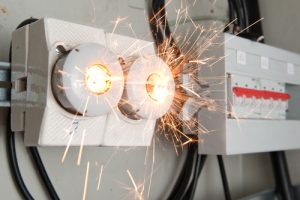- Free Consultation: 866-966-5240 Tap Here To Call Us
California Appeals Court Rules on Industrial Burn Injury Claim

In California, companies that hire contractors and subcontractors are generally not liable when the negligent actions of the contractors or subcontractors cause injury accidents. However, as Sandoval v. Qualcomm Inc., Cal. Ct. App., Case No. D070431 shows, there is an exception to the general rule. When the hiring companies have negligently retained control of the safety conditions at the facilities, the hiring companies may be liable to pay damages if their negligence was a contributing factor to the resulting accidents and injuries. If you have suffered an injury while working for a contractor at a job site, you might want to talk to an experienced lawyer to find out if you might have the basis to file a legal claim against the hiring company.
Factual background of the case
Jose M. Sandoval was employed by ROS Electrical Supply. He was contacted by Mr. Sharghi, a contractor with TransPower. TransPower had been hired by Qualcomm to upgrade Qualcomm’s power generation system in 2013. Qualcomm needed to upgrade the amperage of components called bus bars from 1,200 amps to 2,000 amps. On June 15, 2015, Sharghi inspected the breaker system to see if the bus bars were rated to handle 2,000 amps or if they were 1,200 amps and needed upgrading. During the inspection, Sharghi was unable to see the bus bars inside of a panel. He contacted Sandoval to work as a subcontractor with him and to return to the facility for a new inspection on Aug. 3.
Sharghi reportedly did not tell Sandoval to bring his personal protective equipment, and Sandoval did not bring it. Sandoval had previously been hired to perform work for Sharghi many times, and the two had known each other professionally for more than 20 years. Sharghi testified that he had told Sandoval that they could conduct a safe inspection of the panel because it would be de-energized by Qualcomm. Sharghi, his son Omid, and Sandoval arrived at the Qualcomm facility at 7 am. They signed in and went with three Qualcomm employees to the breaker to conduct the inspection. The Qualcomm employees told Sharghi that one half of the breaker was de-energized while the other part was not. The employees then left the room where the inspection was being conducted.
Sharghi reportedly directed Guadana, a worker who was wearing PPE, to remove a panel on the utility side of the breaker. The utility side was still energized, but Sandoval was not told that it was. Sharghi then got down below the breaker in an attempt to photograph the bus bars from behind the removed panel. While he was doing so, he heard a booming sound and a scream. When he came out, he saw Sandoval covered in blue flames from an arc flash that had occurred from the backside of the breaker where the panel had been removed. Sandoval filed a lawsuit against Qualcomm, ROS Electrical Supply, and TransPower. He listed his employer in the lawsuit because his employer failed to carry workers’ compensation insurance. He sued Qualcomm and TransPower on several negligence grounds.
Issue: Whether Qualcomm retained control over the safety conditions at the facility where the accident occurred?
Sandoval’s case went to a jury trial. At trial, Qualcomm argued that it was not liable for the actions of TransPower or Sandoval as a contractor and a subcontractor. The company argued that it did not retain control over the safety conditions at the facility because its workers told Sharghi which side was energized, and the workers were not in the room when the accident happened. Qualcomm also argued that it had not authorized the removal of the panel, and Sharghi had not gotten permission to remove it before he did so.
The jury found that Qualcomm had negligently retained control over the safety conditions of the facility. It awarded a gross verdict of $1,094,003.42 in economic damages and $6 million in noneconomic damages. The jury found that Qualcomm was 46 percent at fault, TransPower was 45 percent at fault, and Sandoval was 9 percent at fault. Qualcomm filed a motion for a directed verdict in its favor from the court notwithstanding the jury’s verdict. It also filed a motion for a new trial on the apportioning of liability. The court denied the JNOV motion and granted the motion for a new trial on the limited question of the percentage of liability allocated to each party. Qualcomm filed an appeal with the California Court of Appeals.
Rule: Hiring companies are not liable for the actions of their contractors and subcontractors unless an exception applies.
In California, companies that hire contractors are generally not considered to be liable for the negligent actions of the contractors or subcontractors. However, an exception to the general rule occurs when the hiring company retains control over the facility in a negligent manner. Qualcomm argued that it did not retain control because its employees did not take any affirmative action that was negligent and that contributed to the accident and injury. At the trial court level, Qualcomm had requested that the court give a jury instruction with italicized language about affirmative contribution. However, the court declined to give the instruction and instead gave the model jury instruction for retention of control.
Analysis
The court analyzed the trial based on its decision in Regalado v. Callaghan, 3 Cal.App.5th 582 (2016). In that case, an owner-builder hired a pool and spa contractor to build a pool in his backyard. He had installed a pre-engineered pit. A year later, the owner-builder hired a second pool contractor and asked him to install a heated propane tank in the pit to heat the pool. Neither the owner nor the contractor read the instruction manual, which said not to install a propane tank in a pit because of a risk of explosion. The plaintiff turned on the heater after the installation and was severely burned when the propane exploded. The defendant in the case argued that the jury should have been instructed that to be liable, he must have affirmatively contributed to the ultimate explosion.
The court found in Regalado that a hirer can affirmatively contribute to an accident through a negligent omission in safety. It also found that there was sufficient evidence that the homeowner had retained control of the safety conditions of the premises.
When applying the earlier decision to the instant case, the court found that Qualcomm had similarly retained control of the premises. It owned the facility, and its employees turned off part of the breaker system using lock-out/tag-out procedures. While the employees told Sharghi that one side was hot, they failed to tell the other workers, including Sandoval. They then left the room during the inspection when the accident happened.
Conclusion
The appellate court found that the trial court was correct in denying the JNOV motion. It also found that the court was correct in granting a new trial for the limited purpose of examining the apportionment of damages between the parties. The case was sent back to the trial court for a new trial on that limited basis.
Contact the Law Offices of Steven M. Sweat
There are times when hiring companies of contractors and subcontractors might be liable for the negligence of the contracting parties. If you have been injured at a worksite while you were working for a contractor, you may want to talk to an experienced personal injury attorney. Contact the Law Offices of Steven M. Sweat for a free and confidential case analysis. For more information on burn injury claims, click here. For more information on industrial work accident claims in California, click here.
Sources
https://law.justia.com/cases/california/court-of-appeal/2018/d070431.html?utm_source=summary-newsletters&utm_medium=email&utm_campaign=2018-10-26-personal-injury-435aa10eb3&utm_content=text-case-title-1 https://scholar.google.com/scholar_case?case=2104900423835533229&hl=en&as_sdt=6&as_vis=1&oi=scholarr












